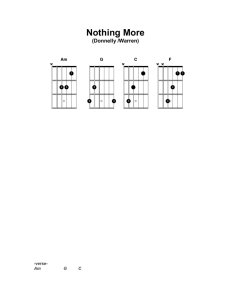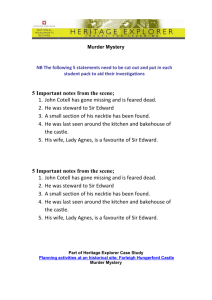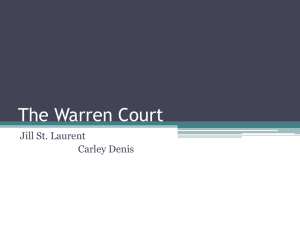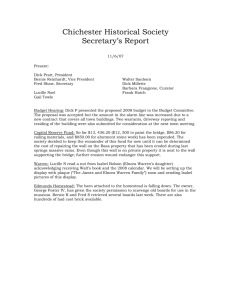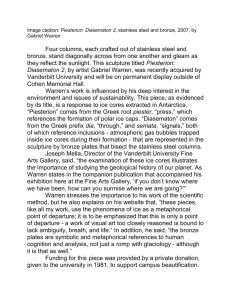An Overview of John Gough Nichols
advertisement
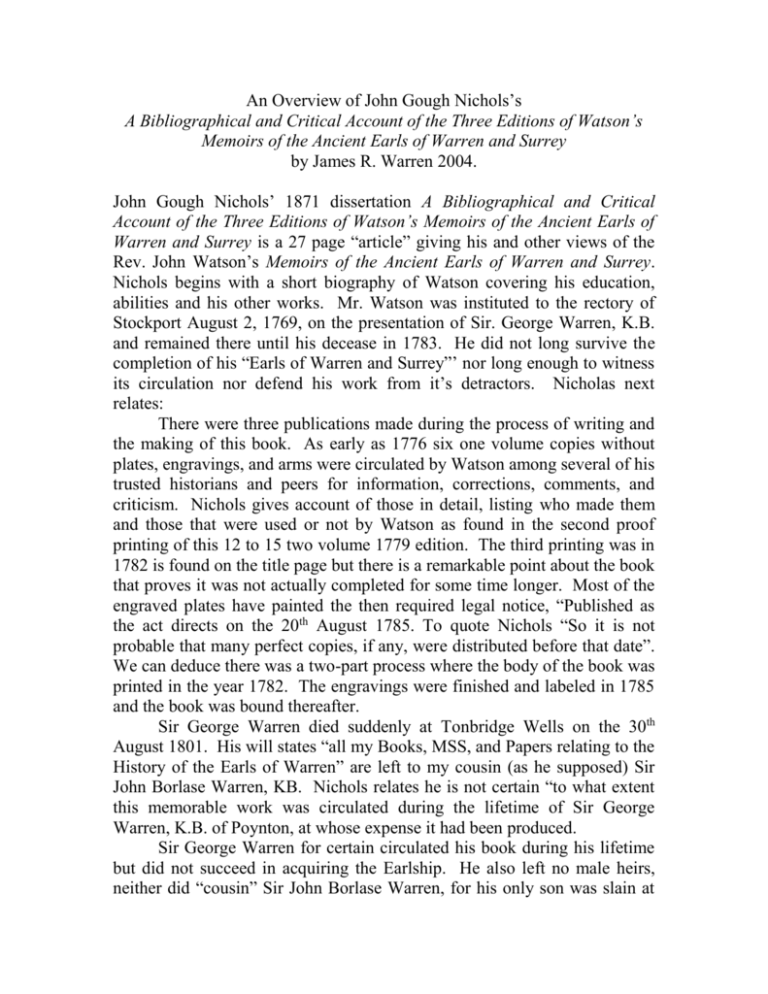
An Overview of John Gough Nichols’s A Bibliographical and Critical Account of the Three Editions of Watson’s Memoirs of the Ancient Earls of Warren and Surrey by James R. Warren 2004. John Gough Nichols’ 1871 dissertation A Bibliographical and Critical Account of the Three Editions of Watson’s Memoirs of the Ancient Earls of Warren and Surrey is a 27 page “article” giving his and other views of the Rev. John Watson’s Memoirs of the Ancient Earls of Warren and Surrey. Nichols begins with a short biography of Watson covering his education, abilities and his other works. Mr. Watson was instituted to the rectory of Stockport August 2, 1769, on the presentation of Sir. George Warren, K.B. and remained there until his decease in 1783. He did not long survive the completion of his “Earls of Warren and Surrey”’ nor long enough to witness its circulation nor defend his work from it’s detractors. Nicholas next relates: There were three publications made during the process of writing and the making of this book. As early as 1776 six one volume copies without plates, engravings, and arms were circulated by Watson among several of his trusted historians and peers for information, corrections, comments, and criticism. Nichols gives account of those in detail, listing who made them and those that were used or not by Watson as found in the second proof printing of this 12 to 15 two volume 1779 edition. The third printing was in 1782 is found on the title page but there is a remarkable point about the book that proves it was not actually completed for some time longer. Most of the engraved plates have painted the then required legal notice, “Published as the act directs on the 20th August 1785. To quote Nichols “So it is not probable that many perfect copies, if any, were distributed before that date”. We can deduce there was a two-part process where the body of the book was printed in the year 1782. The engravings were finished and labeled in 1785 and the book was bound thereafter. Sir George Warren died suddenly at Tonbridge Wells on the 30th August 1801. His will states “all my Books, MSS, and Papers relating to the History of the Earls of Warren” are left to my cousin (as he supposed) Sir John Borlase Warren, KB. Nichols relates he is not certain “to what extent this memorable work was circulated during the lifetime of Sir George Warren, K.B. of Poynton, at whose expense it had been produced. Sir George Warren for certain circulated his book during his lifetime but did not succeed in acquiring the Earlship. He also left no male heirs, neither did “cousin” Sir John Borlase Warren, for his only son was slain at the landing in Egypt in 1801. Sir John gave away several presentation copies that are documented by Nichols who also says: “It was, we presume, after the death of Sir John Borlase Warren in 1822 that the remaining copies of the History of the Earls of Warren and Surrey were brought to a public sale, as thus stated in H. Bohn’s edition (1861) of Lowndes’s Bibliographer’s Manual: “The greater part of this expensively got up book was sold off by auction nearly fifty years ago, and most of the copies were imperfect, wanting especially the folding plate of Earl Warren drawing his sword before the Commissioners of Edward I. and the folding view of Poynton Lodge, Cheshire.” However, Nichols finds otherwise for in all of the 1782 third edition copies he has studied the plates are included. He continues “We have seen it stated in a bookseller’s catalogue that the number printed of the third and last edition was 250: and that statement is very probably the truth. Upon similar authority we learn that the copper-plates are preserved at Sudbury Hall, the seat of Lord Vernon.” At this point Nichols gets to the heart of the matter by stating that reception of Memoirs as a remarkable library book is acknowledged but did it accomplish is goal in re-establishing the Earldom of Warren? Due to the manner in which it was published and distributed and the death of its author Memoirs did not attract much notice or receive the ordinary reviews of the time. “But at subsequent periods deliberate opinions upon its merit have been publicly expressed by at least five eminent genealogists, Sir. Egerton Brydges, Dr. Whitaker, Ormerod, Townsend (as expressed by Dallaway), and Joseph Hunter.” Nichols proceeded to list their criticisms: The first found in Sir Egerton Brydges’ Censura Literaria, 1805, vol. i. pp. 19-23, 181-191, he says “though much inclined to learn, with a kindred kindness, to the plausibility of the claim, yet I am obliged to admit that a critical attention to all that Watson, with the aid of these authorities [Flower and Glover], has been able to urge in favor of the latter mode [of descent], induces me to confess that he leaves the matter in very great doubt” On the important point how far the descent, if perfectly proven, would have established a claim to the Earldom, Sir Egerton Brydges is silent. Dr. Whitaker, in his Loidis and Elmete, 1816, vol. i. p. 277, showed that the Author proceeded on an entirely mistaken argument, in imagining that the Earldom could devolve on a male line of Warren, however distinctly established in pedigree. Isabel, the daughter and heiress of the third Earl, had carried it successively to her two husbands: it was inherited by her descendants, and they must be all proved extinct, which is by no means the case, before the dignity would revert to any junior branches in the male line. But Dr. Whitaker, in conclusion, admitted that he was “bound in justice to add, that the legitimacy of the Warrens of Poynton appears to be fully proved by this historian,” Dr. Ormerod the Historian of Cheshire (in his vol. iii. p. 310), presented a fair review of the known evidence, and of the arguments pro et con, but was obliged to leave the question still in doubt. We will quote his exposition of the whole discussion, for the benefit of those to whom it may be new:-Sir Edward Warren appears to have been the husband of Maud surnamed of Nerford, daughter and co-heir of Richard de Skegeton, and according to every authority was descended, either legitimately or otherwise, from the Earls of Warren; but the authorities differ as to the precise mode of the descent. On this subject, as Watson observes (House of Warren, ii. 75-82), there are three options, but the second of these may be again subdivided. The first opinion (that of Vincent, and the one which has been generally believed,) states this Sir Edward to be son of John de Warren, bastard son of John the eighth Earl by his concubine Maud de Nerford. The only objection to this supposition is that the King, who was last in the Earl’s settlement, entered, instead of Sir Edward, upon the lands settled on this John de Warren’s lawful male issue. (Watson, ii. 76-77) The second is contained in the pedigree drawn up by Glover (Vincent’s Cheshire, Coll. Arm.) which makes the said John (father of Sir Edward) legitimate son of John seventh Earl Warren; and this account is varied by Sir John Borlase Warren’s pedigree, which makes Sir Edward legitimate son of the seventh Earl himself. (Ibid. 77-80.) The third and last occurs in the Poynton pedigree, as drawn by Flower and Glover in 1580, viz. that Sir Edward was son of John, son of Sir John, son of William, which William was unquestionably son of Reginald de Warren, a younger brother of William the third Earl. An establishment of this hypothesis was the object with which Mr. Watson’s History of the Warrens was written, and the result was an admirable account of the great Earls of that title, and of the family of the same name which settled at Poynton, each branch being severally traced and identified by every means which antiquarian research could supply; but with respect to the link between the families, to the two Johns de Warren who intervene in Glover’s pedigree between William, nephew of the third Earl, and Sir Edward, the ancestor of the Poynton branch, without where identification the whole falls to the ground, it must be owned that the reader will only find (in pp. 88-89, vol. ii.) the unsupported assertions of Glover repeated, without confirmation, or even an attempt at confirmation. It was in the same year (1819) that Dallaway published his History of the Rape of Arundel, in which, at pp. 121-123, he discusses the question of the descent of the Warrens of Poynton, showing the several theories of Flower and Glover, Vincent and Dugdale, and lastly of Watson. He appends some valuable observations, which were communicated to him by Francis Townsend, Windsor Herald, then engaged in collecting materials for a new edition of Dugdale’s Baronage. These include proofs that the Earl was never divorced from his wife Isabel de Barre, the granddaughter of King Edward I. nor married to Isabel de Holland, whom in his will he terms his compatigae. Dallaway dismisses Watson’s book with this criticism, that it is “elaborate as to the historical collection for the House of Warren, but conjectural as to the establishment of its main point.” It was reserved to Joseph Hunter, the Historian of South Yorkshire, to verify and establish the older belief, that the Warrens of Poynton were really an illegitimate branch of the ancient house, descended from John the last Earl (ob. 1347) by his concubine Maud de Nerford. He found, however, that the Earl’s bastard son, the ancestor of the Poynton family, was not John, but Sir Edward Warren. In his History of South Yorkshire, 1828, vol. i. 101-110, under Coningsborough &c., Mr. Hunter has given the best and most reliable account of the Warrens; but he also communicated to the last number of the Retrospective Review (Second Series, 1828, ii. 527) a precis of the argument, which will now bear repetition:-THE WARRENS OF POYNTON, -- The principal object of “The History of the House of Warren,” a work in which it is manifest that great attention was given to the subject its learned author, was to prove that a race of gentry of the same name of Warren, who had resided, from the reign of Edward III. at Poynton, near Stockpot, in Cheshire, were in legitimate descent from the ancient Earls of Warren; and that, being so descended, the head of that family had a right to the Earldom of Warren. The second position was a palpable non sequiter. For if it could have been proved, to the satisfaction of a Lord’s Committee, that Sir George Warren did descend in the line contended for by Mr. Watson, it would by no means have followed that he was entitled to the rank and privileges of Earl of Warren, if any where, to the issue of his sister, the Countess of Arundel.1 In his first position he appears to be equally in error. He has shown indeed that Vincent and Dugdale are both wrong when they deduce the Warrens of Poynton from John de Warren, an illegitimate son of the last Earl. He has also produced very probable reasons why the Warrens of Poynton did not descend, as others have conjectured, from a John de Warren, said to be son of John the seventh Earl, who died in 1304, by a second wife, a daughter of Mowbray. But it does not follow that, having cleared away these two hypotheses, the third which he adopts becomes established as indisputably true. We are persuaded indeed that that hypothesis is equally without the support of evidence, and in opposition to very pertinent probabilities, with the two which Mr. Watson has ably disposed of. It is admitted that the Poynton family descend from a Sir Edward Warren, who was living in the reign of Edward III. This is a point about which there is no dispute. The question is, how Sir Edward was connected with the Earls? Mr. Watson deduces his descent from Reginald, a second son of William the second Earl (and consequently grandson to Gundred the daughter of the Conqueror), who is said to have had by Adeliza, a daughter of Roger de Mowbray, William, his only son and heir; who, by Isabel, a daughter of Sir William de Haydon, had Sir John Warren; who, by Alice, daughter of Roger de Townsend, had another Sir John; father to Sir Edward, by Joan, daughter of Sir Hugh Port. Now, we have an attempt to prove the existence of the two Sir Johns: no inquisitions (for the latter of these at least must have lived within the period through which we are so rich in that species of evidence): no reference to any thing which has the semblance of authority for the marriages with Townsend and Port. The whole is taken from an unsupported pedigree, which purports to have been prepared by Flower and Glover, but which would seem to betray some inferior hand, when it gravely states that Hugh Capet was the son of Osmund de Comitus Villa, by Warina sister to Herfastus, did we not know that the truly respectable name of Glover is subscribed to other Northern pedigrees, in which there are errors as palpable. We think therefore that, till there is something to prove the existence at least of these two Sir Johns and their wives, it were too much to call upon his Majesty to allow a dignity to their supposed personal representative which would have had the effect of placing him above all the Earls of the realm. We think moreover that the true descent of Sir Edward Warren, and consequently the relation in which the Warrens of Poynton stand to the Earls of Warren, is shown in a very satisfactory manner in a volume relating to the topography of the south part of Yorkshire, which has been lately published. It was known to Dugdale that the last Earl of Warren, who died in 1347, left a will which was entered in the register of Zoueh, Archbishop of York. Mr. Watson when he was preparing his History of the House of Warren inquired for this will; but to his great mortification found that Zoueh’s register which contained it was lost. He was therefore compelled to take his knowledge of it from the few notices of its contents to be found in Dugdale’s Baronage. In the course of researches made for the topographical work just referred to, the author discovered, not indeed the original register, but a very valuable abstract of it made by Dugdale’s great friend and coadjutor Dodsworth; and in that abstract a much more ample notice of the contents of the Earl’s will than is to be found in the Baronage. He mentions in it several children, males and females, all of whom must have been illegitimate; and amongst them occurs the name of Edward de Warren, to whom he leaves 20£. It is then for the first time shown that the last Earl of Warren had a son who bore the name of Edward; and as the house of Poynton is known to descend from an Edward de Warren, who must have been contemporary with that Edward; as there was a strong current of tradition that it did descend from an illegitimate son of the last Earl of Warren; as the distinction in the arms of the Warrens of Poynton was a lion rampant ermine, which was the coat of Nerford, and as there also is an absence of all evidence for any other descent of Sir Edward Warren, the undoubted ancestor,-- we confess we see not how the conclusion can be evaded that he is the Edward de Warren named in the will, a son, but not legitimate, of the eighth and last Earl. The name of Warren was allowed to all issue of the Earl. This appears to have been on the same principle that the Cornwalls, Barons of Burford, and the Somersets, now Dukes of Beaufort, had their surnames. The one descended from an Earl of Cornwell, the other from an Earl of Somerset. So the Earl of Warren gave the name of his earldom to his illegitimate sons. Another illegitimate son of the Earl of Warren not noticed by Watson, named Ravelyn, is mentioned in the Rolls of Parliament, 9 Edward III. We have one more remarkable particular to give before we close this article. Mr. Watson is said to have inquired in vain for the Register of Archbishop Zoneh, and in vol. Ii. P. 50, he stated that it was “unfortunately lost.” In this supposition Mr. Hunter acquiesced. But, if ever missing or mislaid, it has been recovered, and has, with the other registers of its series, been made to render forth its treasures of information by the Surtees Society. The will of the last Earl Warren will be found at length in the Testamenta Eboracensia, vol. i. 41-47, and it is one of the most curious and interesting in that collection. The Earl’s surviving children by Maud de Nerford were then grown up and some married, and he had another compaigne named Isabelle de Holand. The following are the passages in which he mentions the new connections he had thus acquired, and his children— Jeo devys a dame Maude de Holand iiij jumentz de mon haratz de Sussex.3 Jeo devys a monsire Robert de Holande les quissers ove le picer de quir qui sount pour mon destrer.4 Jeo devys a monsire Otes de Holande les covertures burnutz de plate qui sount pour mon destrer.5 Jeo devys a monsieur William de Warenne mon filz cent mares, ma hure d’argent dorre pour Strathorne, ove la cerele d’argent pour yeel, deus taches et le latz dargent dorretz pour le mauntel, et tout mon hernoys pour le jouster.6 Et a ma filla sa compaigne j nouche d’or. Jeo devys a Edward de Warenne mon filz vynt I. Jeo devys a Johan de Basyngg ma fille une coupe dargent pleyne. Jeo devys a Katherine ma fille dys mare. Jeo devys a Isabelle ma fille, noneyne de Sempryngham, vynt 1. Jeo devys a daunz William de Warenne mon filz ma bible que jai fait faire en Fraunecys, et qule demoerge en la meson ou il sorra priour après son decease en perpetual memoire de moy. Here are enumerated the Earl’s surviving children, probably in the order of their birth. The eldest was Sir William, and he had a wife, but whose name does not appear. Edward was the second, the ancestor of the Warrens of Poynton. The eldest daughter had acquired another name by marriage. Katharine was unmarried; and Isabel was a nun at Sempringham. Lastly is mentioned Don William (the second of that name), who had become prior of Horton in Kent in 1338. After many other legacies, one of which we cannot pass over without noticing its heraldic interest, Jeo devys a mousier William de Friskeneye dens botels d’argent ove escuchounz des armes monsire Johan de Breouse. We arrive at a long catalogue of articles bequeathed to Isabelle de Holand, commencing thus— Jeo devys a Isabelle de Holand ma compaigne mon auel d’or ove le banc rubye, baquinze anels d’or par constellation qui sont en mon Egle d’or,4 ensi q’ele métier autres anels en lour liens tiels come lui plerra, les principals vestementz cutiers pour ma chapelle, &c. &c. &c. The will was made in the castle of Conisborough on the 24th June 1347, and proved on the 26th of the following month. The term ma compaigne applied to Isabelle de Holand has puzzled genealogists; for they knew that it meant at the time nothing less than wife. Indeed in this very document it is applied in that sense to the testator’s daughter-in-law the wife of Sir William de Warren; and the Earl’s nephew and successor in the Earldom of Surrey, Richard Earl of Arundel, in his will dated 1375, designates his wife of royal blood as “ma treschere compaigne Alianore de Lancastre.” We must conclude that the Earl of Warren chose to regard and to style Isabelle de Holand as his wife, although he had failed to procure a divorce from his actual wife Joan de Barre, a granddaughter of King Edward I., who survived him, and is styled Countess of Surrey after his death. J. G. N.
